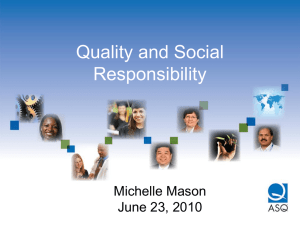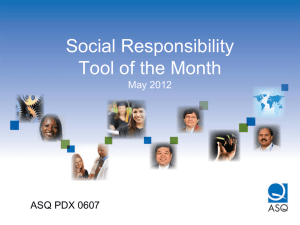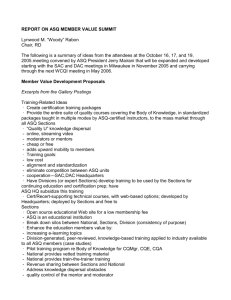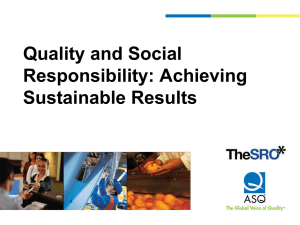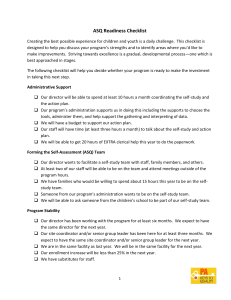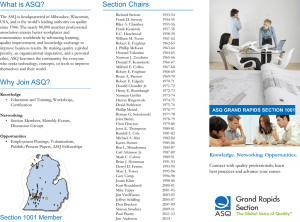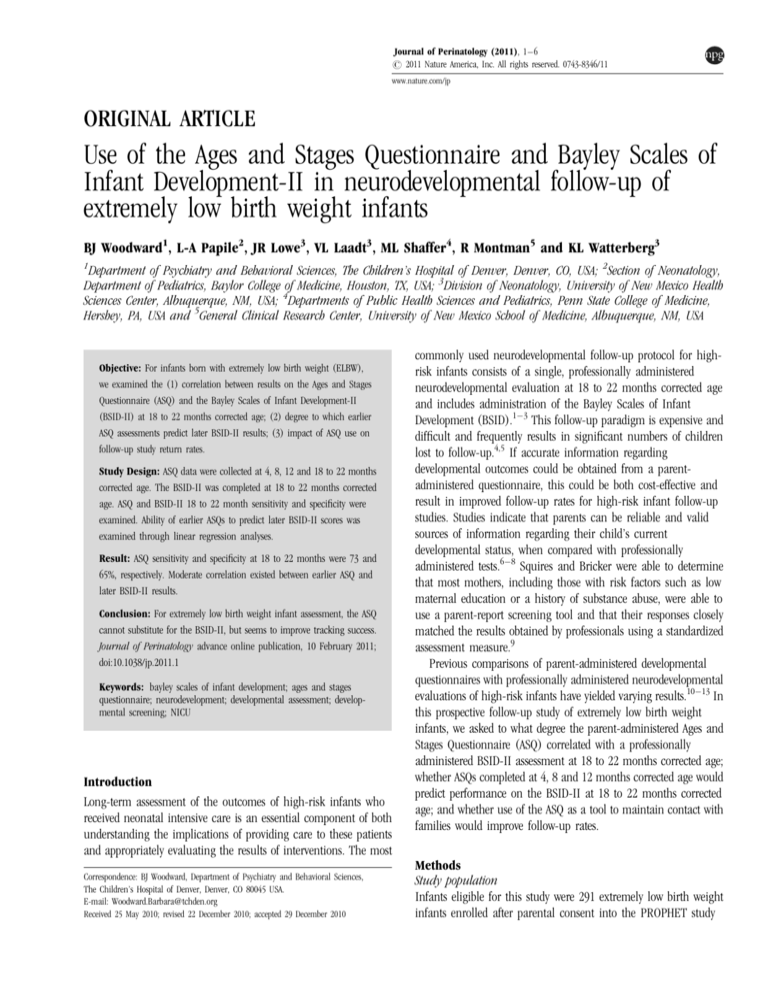
Journal of Perinatology (2011), 1–6
r 2011 Nature America, Inc. All rights reserved. 0743-8346/11
www.nature.com/jp
ORIGINAL ARTICLE
Use of the Ages and Stages Questionnaire and Bayley Scales of
Infant Development-II in neurodevelopmental follow-up of
extremely low birth weight infants
BJ Woodward1, L-A Papile2, JR Lowe3, VL Laadt3, ML Shaffer4, R Montman5 and KL Watterberg3
1
Department of Psychiatry and Behavioral Sciences, The Children’s Hospital of Denver, Denver, CO, USA; 2Section of Neonatology,
Department of Pediatrics, Baylor College of Medicine, Houston, TX, USA; 3Division of Neonatology, University of New Mexico Health
Sciences Center, Albuquerque, NM, USA; 4Departments of Public Health Sciences and Pediatrics, Penn State College of Medicine,
Hershey, PA, USA and 5General Clinical Research Center, University of New Mexico School of Medicine, Albuquerque, NM, USA
Objective: For infants born with extremely low birth weight (ELBW),
we examined the (1) correlation between results on the Ages and Stages
Questionnaire (ASQ) and the Bayley Scales of Infant Development-II
(BSID-II) at 18 to 22 months corrected age; (2) degree to which earlier
ASQ assessments predict later BSID-II results; (3) impact of ASQ use on
follow-up study return rates.
Study Design: ASQ data were collected at 4, 8, 12 and 18 to 22 months
corrected age. The BSID-II was completed at 18 to 22 months corrected
age. ASQ and BSID-II 18 to 22 month sensitivity and specificity were
examined. Ability of earlier ASQs to predict later BSID-II scores was
examined through linear regression analyses.
Result: ASQ sensitivity and specificity at 18 to 22 months were 73 and
65%, respectively. Moderate correlation existed between earlier ASQ and
later BSID-II results.
Conclusion: For extremely low birth weight infant assessment, the ASQ
cannot substitute for the BSID-II, but seems to improve tracking success.
Journal of Perinatology advance online publication, 10 February 2011;
doi:10.1038/jp.2011.1
Keywords: bayley scales of infant development; ages and stages
questionnaire; neurodevelopment; developmental assessment; developmental screening; NICU
Introduction
Long-term assessment of the outcomes of high-risk infants who
received neonatal intensive care is an essential component of both
understanding the implications of providing care to these patients
and appropriately evaluating the results of interventions. The most
Correspondence: BJ Woodward, Department of Psychiatry and Behavioral Sciences,
The Children’s Hospital of Denver, Denver, CO 80045 USA.
E-mail: Woodward.Barbara@tchden.org
Received 25 May 2010; revised 22 December 2010; accepted 29 December 2010
commonly used neurodevelopmental follow-up protocol for highrisk infants consists of a single, professionally administered
neurodevelopmental evaluation at 18 to 22 months corrected age
and includes administration of the Bayley Scales of Infant
Development (BSID).1–3 This follow-up paradigm is expensive and
difficult and frequently results in significant numbers of children
lost to follow-up.4,5 If accurate information regarding
developmental outcomes could be obtained from a parentadministered questionnaire, this could be both cost-effective and
result in improved follow-up rates for high-risk infant follow-up
studies. Studies indicate that parents can be reliable and valid
sources of information regarding their child’s current
developmental status, when compared with professionally
administered tests.6–8 Squires and Bricker were able to determine
that most mothers, including those with risk factors such as low
maternal education or a history of substance abuse, were able to
use a parent-report screening tool and that their responses closely
matched the results obtained by professionals using a standardized
assessment measure.9
Previous comparisons of parent-administered developmental
questionnaires with professionally administered neurodevelopmental
evaluations of high-risk infants have yielded varying results.10–13 In
this prospective follow-up study of extremely low birth weight
infants, we asked to what degree the parent-administered Ages and
Stages Questionnaire (ASQ) correlated with a professionally
administered BSID-II assessment at 18 to 22 months corrected age;
whether ASQs completed at 4, 8 and 12 months corrected age would
predict performance on the BSID-II at 18 to 22 months corrected
age; and whether use of the ASQ as a tool to maintain contact with
families would improve follow-up rates.
Methods
Study population
Infants eligible for this study were 291 extremely low birth weight
infants enrolled after parental consent into the PROPHET study
ASQ and BSID-II in NICU follow-up of ELBW infants
BJ Woodward et al
2
and who survived to hospital discharge. The PROPHET Study was a
multicenter, randomized, placebo-controlled trial of early and lowdose hydrocortisone to prevent bronchopulmonary dysplasia.14
Eligibility criteria for that study included birth weight between
500 and 999 g and the need for mechanical ventilation at 12
to 48 h of age.
Study procedures
Neurodevelopmental evaluation of infants enrolled in the
PROPHET study included administration of the BSID-II and
neurological examination by certified examiners at 18 to 22
months corrected age.3 Families were separately consented for the
ancillary ASQ study and were asked to complete an ASQ when their
child was 4, 8, 12 and 18 to 22 months corrected age.
Approximately 2 weeks before an infant turning 4, 8, 12 and 18 to
22 months corrected age, an age-appropriate ASQ form was mailed
to the home. Completed ASQs were either mailed back to the center
(families were provided with stamped and addressed envelopes) or
the research coordinator called the family and obtained the
answers to the ASQ by phone. If the family had not completed the
18 to 22 month ASQ before the professional neurodevelopmental
evaluation, the family was asked to complete the ASQ on site.
Developmental assessment tools
The BSID15 includes Mental (mental development index) and
Psychomotor (psychomotor development index) Scales, as well as a
Behavior Rating Scale. Raw scores on the BSID-II are converted to
standardized scores with a mean of 100 and a s.d. of 15. For this
study, a standard score of 70 or below, which is 2 s.ds below the
mean, was considered a ‘fail’ on either the Mental or Psychomotor
Scale of the BSID-II.
The ASQ: a parent-completed, child-monitoring system16 is a
screening tool that uses parent observation to assess child
development and behavior. Questionnaires are available at
2-month intervals from 4 to 24 months and at 30-, 33-, 36-, 48-,
54- and 60-months age points. The standardized assessment
window begins 1 month before and ends 1 month following each
questionnaire age point. Questions are written at a 4th to 6th grade
reading level so that most parents can complete them
independently. The questionnaires also can be used in an interview
format for those who have difficulty with reading or language. The
ASQ questionnaire at each age point contains six questions in each
of five domains of development-communication, fine motor, gross
motor, problem solving and personal social, for a total of 30
questions. Answer options for each question include ‘yes’,
‘sometimes’ or ‘not yet’. A ‘yes’ response receives 10 points,
‘sometimes’ receives 5 points and ‘not yet’ receives 0 points. Each
of the five domains is scored separately. These separate scores are
not added together to obtain a composite score. A score of 2 s.ds or
more below the mean in any one of the domains is considered a
‘fail’ on the ASQ.16
Journal of Perinatology
Statistical analysis
To examine the relationship between the 18 to 22 month ASQ and
the BSID-II, a 2X2 contingency table was constructed where the
rows and columns were determined by a pass or fail of the ASQ and
BSID-II, respectively. From this table, the test characteristics of the
ASQ were calculated, including the sensitivity, specificity and
positive and negative predictive values. The ability of the ASQ to
predict performance on the Bayley Mental Scale and the Bayley
Psychomotor Scale was examined using linear regression analysis
without adjustment for other factors. The Spearman’s rank
correlation coefficient was used to measure the degree of
association between the percentage of subjects with two or more
ASQs completed and the follow-up rate. Analyses were conducted
using SAS Version 9 (SAS Institute, Cary, NC, USA).
Results
Of the 291 infants who survived to discharge, 250 completed the
BSID-II at 18 to 22 months corrected age. Of the 250 children who
completed the BSID-II, 219 also completed at least one of the
possible four ASQ questionnaires. Table 1 shows the eight unique
ASQ patterns of return across the four age points. Of the 228
children, a total of 78 ASQs were completed at 4 months, 95 at 8
months, 105 at 12 months and 228 at 18 to 22 months. As
illustrated, nine of the children with one or more ASQs did not
complete the BSID-II evaluation. Characteristics for the 228
children in this study included: mean birth weightF738.5 g
Table 1 Patterns of return of the ASQs
ASQ Completion and Return Age Points
Pattern
of
ASQ
Return
ASQ
ASQ
ASQs
completed completed completed
at 12
at 8
at 4
months. months. months.
ASQ completed
at 18 to
22 mos.
Also the BSID-II Not the BSID-II
Exam
Exam
A
B
C
D
E
F
G
H
Totals
0
0
0
21
0
11
13
33
78
0
0
15
0
34
0
13
33
95
0
27
0
0
34
11
0
33
105
65
27
15
21
34
11
13
33
219
1
3
0
3
1
1
0
0
9
Abbreviations: ASQs, Ages and Stages Questionnaires; BSID-II, Bayley Scales of Infant
Development-II.
n ¼ 228 children.
Eight patterns of ASQ return are illustrated across 4 age points: 4, 8, 12 and 18 to 22
months. The 18 to 22 month column indicates whether the BSID-II exam was completed.
ASQ and BSID-II in NICU follow-up of ELBW infants
BJ Woodward et al
3
Table 2 Sensitivity/specificity of the 18 to 22 month ASQ and BSID-II
(a)
BSID-II
ASQ
Passa
Failb
Total
Passa
Fail b
Total
71
39
110
16
43
59
87
82
169
(b)
BSID-II
ASQ
Passc
Faild
Total
Passa
Fail b
Total
35
75
110
3
56
59
38
131
169
(c)
BSID-II
ASQ
Passa
Failb
Total
Passe
Fail f
Total
47
16
63
40
67
107
87
83
170
Abbreviations: ASQs, Ages and Stages Questionnaires; BSID-II, Bayley Scales of Infant
Development II; NPV, negative predictive value; PPV, positive predictive value.
(a): Sensitivity: 73% (PPV ¼ 52%); Specificity: 65% (NPV ¼ 82%).
(b): Sensitivity: 95% (PPV ¼ 43%); Specificity: 32% (NPV ¼ 92%).
(c): Sensitivity: 63% (PPV ¼ 81%); Specificity: 75% (NPV ¼ 54%).
a
p2 s.d. below the mean.
b
>2 s.d. below the mean.
c
p1 s.d. below the mean.
d
>1 s.d. below the mean.
e
p1 s.d. below the mean.
f
>1 s.d. below the mean.
(500 to 997 g.); mean gestational ageF25.4 weeks (23.0 to 31.0
weeks); genderFmales 121 (53.1%), females 107 (46.9%);
ethnicityFNon-Hispanic white 117 (51.3%), Black 73 (32.0%),
Hispanic 27 (11.8%), other 11(4.8%); median total household
income was $30 000 to $40 000.
Relationship between the BSID-II and ASQ at 18 to 22 months
Table 2a presents the test characteristics of the ASQ, including the
sensitivity, specificity, and positive and negative predictive values.
When using cutoff points of >2 s.d. below the mean on either the
Mental Development Index or Psychomotor Development Index of
the BSID-II as a ‘fail’ and a score of >2 s.d. below the mean on
any of the domains of the ASQ as a ‘fail’, the ASQ had a sensitivity
of 73% and a specificity of 65%. The positive predictive value was
52% and the negative predictive value was 82%. In all, 16 of 59
children who scored poorly (>2 s.d. on either the Mental or
Psychomotor Scale) on the BSID-II would have been missed by the
ASQ, whereas 39 of 110 children would have been incorrectly
identified as having a developmental delay. Thus, the clinical
epidemiological characteristics (sensitivity and specificity) of the
ASQ in relationship to the BSID-II did not reach suggested levels of
80% (see ref. 17).
We evaluated the effect of using a ‘fail’ cut-off on the ASQ of
>1 s.d. below the mean, rather than >2 s.d. Table 2b shows the
corresponding shifts in the sensitivity, specificity, positive and
negative predictive values. The shift from 2 s.d. to 1 s.d. below the
mean resulted in improved sensitivity with the ASQ only ‘missing’
three children with a developmental delay. On the other hand, 75
children would have been incorrectly considered as suspect for a
developmental delay but were found to be above the BSID-II cut off
of 2 s.d. below the mean, thus decreasing the specificity to 32%.
We also examined the effect on sensitivity and specificity rates by
shifting the s.d. of the BSID-II to >1 s.d. below the mean, while
keeping the ASQ at >2 s.d. We found that the sensitivity rate
dropped to 63%, whereas the specificity improved slightly to 75%
(see Table 2c).
Early ASQ prediction of 18–22-month BSID-II
As illustrated in Table 1, a total of 154 children had at least one
completed ASQ at age 4, 8 and/or 12 months, plus completed the
BSID-II at 18 to 22 months corrected age. Excluded from this subsample were the 65 children who had no ASQ results before the 18
to 22 month BSID-II evaluation and nine children who had ASQs
completed but were not brought in for the BSID-II evaluation. As
illustrated in Table 1, the number of ASQs completed per child over
the three age points of 4, 8 and 12 months was variable; therefore,
the number of ASQs available for calculations at each age point is
different.
Tables 3 and 4 present the regression results as coefficients of
multiple correlation using combinations of the ASQ at 4, 8 and 12
months to predict performance on the 18 to 22 month Bayley Mental
Scale (Table 3) and Psychomotor Scale (Table 4). Overall predictability
was mild to moderate for each of the scales, indicating that the
majority of the variability in the BSID-II still needs to be explained
after accounting for ASQ performance. The combination of the 4 and
12 month ASQ data points was the strongest predictor of the 18 to 22
month BSID-II Mental Scale (R2 ¼ 0.23; R ¼ 0.48) and Psychomotor
Scale (R2 ¼ 0.32; R ¼ 0.57).
ASQ use as a population tracking and retention mechanism
The rates of return for the 18 to 22 month follow-up visit were
compared with numbers of completed ASQs per participating
Journal of Perinatology
ASQ and BSID-II in NICU follow-up of ELBW infants
BJ Woodward et al
4
Table 3 Coefficients of multiple correlation between ASQs and BSID-II MDI
Table 4 Coefficients of multiple correlation between ASQs and BSID-II PDI
Age at ASQ (months)
4
8
12
4+8
4+12
8+12
4+8+12
n
R
BSID-II Mean
P-value
Age at ASQ (months)
73
93
103
45
42
67
33
0.41
0.45
0.45
0.29
0.48
0.44
0.47
80.55
81.72
81.76
83.09
84.62
83.33
85.70
0.002
<0.001
<0.001
0.050
0.001
<0.001
0.006
4
8
12
4+8
4+12
8+12
4+8+12
Abbreviations: ASQs, Ages and Stages Questionnaires; BSID-II, Bayley Scales of Infant
Development II; MDI, Mental development index.
n
R
BSID-II Mean
P-value
75
93
104
45
43
67
33
0.46
0.36
0.44
0.40
0.57
0.41
0.44
85.75
85.97
86.21
88.84
89.95
86.91
90.42
<0.001
0.002
<0.001
0.006
<0.001
<0.001
0.011
Abbreviations: ASQs, Ages and Stages Questionnaires; BSID-II, Bayley Scales of Infant
Development II; PDI, Psychomotor Development Index.
research center. Using a Spearman’s correlation coefficient, a
significant positive correlation (rs ¼ 0.71) was found when two or
more ASQs were completed per child before the 18- to 22-month
evaluation as shown in Figure 1.
Discussion
Although the ASQ holds promise for supporting the efforts of
measuring the development of young children born with extremely
low birth weight, the clinical epidemiological characteristics
(sensitivity and specificity) of the ASQ in relationship to the BSIDII did not reach suggested levels of 80% (see ref. 17). Although the
values came close to meeting suggested guidelines for accurate
classification of children, the number of children who would be
correctly identified as not having a developmental delay
(specificity) is not strong enough to assert that the ASQ provides
accurate classification when compared with the BSID-II. Specificity
values declined even further when the cutoff score for failure on
the ASQ was shifted from 2 s.d. to 1 s.d.
Skellern, et al.13 reported overall sensitivity and specificity rates
for the ASQ of 90 and 77%, respectively. Their study used an ASQ
cutoff score of >2 s.d., but adjusted the cutoff score of the
evaluation tools (BSID-II, Griffith Mental Development Scales, and
the McCarthy Scales of Children’s Abilities General Cognitive
Intelligence Scale) to >1 s.d. When we shifted to a combination of
ASQ cutoff scores of >2 s.d. and cutoff scores of >1 s.d. for the
BSID-II, sensitivity dropped to 63%, whereas the specificity
improved toward acceptable levels (75%). It is interesting to note
that when Skellern et al. used either the Griffith Mental
Development Scales or the McCarthy scales of Children’S Abilities
General Cognitive Intelligence Scale, they achieved much higher
sensitivity and specificity values for the ASQ than they did when
using the BSID-II as the index evaluation tool. A number of studies
have attempted to determine whether scores obtained during the
first 2 years of life, using professionally administered
developmental measures such as the BSID-II, can predict later
outcomes. Most of these studies reveal weak correlations.18–21
Journal of Perinatology
Figure 1 Per center comparison between the percentage of children who had
two or more Ages and Stages Questionnaires (ASQs) with the percentage of Bayley
Scales of Infant Development II (BSID-II) evaluations completed (rs ¼ 0.71).
Each data point represents one research center.
For this study, the ASQs completed at 4, 8 and 12 months had
mild to moderate correlations with the Mental Development Index
and Psychomotor Development Index of the BSID-II administered
at the 18 to 22 month corrected age point. It is interesting to note
that correlations with the Psychomotor Development Index
improved when using either the 4- or 12-month ASQ results, or
when the 4- and 12-month ASQ scores were added in combination.
The use of the ASQ seemed to support efforts to retain infants in
the PROPHET study until the time of the 18 to 22 month
professionally administered developmental evaluation. A significant
positive correlation (rs ¼ 0.71) was found between a family’s
completion of two or more ASQs and their return for the
professional evaluation. The possibility exists, however, that
families who are motivated to return to a center for an evaluation
of their child’s development, also would be more likely to complete
and return ASQ questionnaires. It also should be noted that more
frequent family contact in any form improved follow-up rates. One
urban center had a high follow-up rate with few ASQs completed.
ASQ and BSID-II in NICU follow-up of ELBW infants
BJ Woodward et al
5
Their protocol was to bring children in to the follow up clinic every
3 months. Although frequent returns to the hospital/clinic may be
physically and financially possible in more urban areas, this might
not be feasible in more rural settings.
Most of the research coordinators indicated that they liked using
the ASQ because it gave them a reason for contacting the families.
They related that families who completed the ASQs appreciated the
knowledge gained about their child’s developmental progress.
Several coordinators indicated that information gathered through
the ASQ process helped families to better understand their child’s
developmental status. In this way developmental findings
determined at the study evaluation were not unexpected and thus
were less traumatic for the family.
One limitation of this study was the relatively small number of
ASQs at each of the earlier age points. This fact might have
influenced the results regarding the ASQ’s ability to predict BSID-II
scores at 18–22 months. These smaller numbers also did not allow
for examination of any possible influences related to
sociodemographical factors.
In addition, it should be noted that since the completion of this
study, the ASQ-3 (see ref. 22) and the BSID-III (see ref. 23) have
been published. The ASQ-3 has additional age intervals, cutoff
scores have been revised, and the scoring sheet displays the cutoff
point for 1 s.d. below the mean. The BSID-III contains five subtests
including motor, language, cognitive, social-emotional and
adaptive behavior, which may allow for more direct
comparisons between the domains of the ASQ-3 and the
BSID-III in future studies.
Another relevant comparison worthy of consideration is that
between the BSID-III and the BSID-II (see ref. 24), where
significant differences have been shown. Mean composite scores on
the BSID-III are reported to be B7 points higher than mean index
scores on the BSID-II (see ref. 24). Depending upon one’s view of
the relative strengths of each tool, either the BSID-II overestimates
delays or as Anderson et al.25 indicate, the BSID-III ‘seriously
underestimates’ developmental delay. It seems that more work
needs to be done to discover which of the available assessment
tools, the BSID-II, BSID-III, ASQ or others, best document current
developmental status and in addition is the best predictor of child
outcomes.
In summary, the results of this study indicate that the ASQ does
not have strong enough clinical epidemiological properties to
support replacing the BSID-II for neonatal intensive care unit
(NICU) follow-up studies. More positively the results of the ASQ
may give researchers some indication of the child’s development if
the family does not return for the professionally administered
evaluation. The ASQ also helps families to feel included in the
process of monitoring their child’s development and provides them
with valuable developmental information. It is possible that the
periodicity of the ASQ process may encourage families to continue
their connection with the research center and thus may be a useful
adjunct to prospective neurodevelopmental research outcome
studies as an effective tracking and population-retention
mechanism.
Accurate determination of developmental outcomes of newborns
cared for in the neonatal intensive care unit is critical to informing
ongoing care. However, the question must be posed as to whether
the current paradigm of a one-time professionally administered
evaluation, before2 years of age, is yielding accurate information
about developmental outcomes. As previously noted, developmental
evaluations performed in the early years have not been found to be
predictive of later outcomes.18–21 The question needs to be raised
as to whether a periodic parent-administered measure, such as the
ASQ, may yield better predictive information. Studies contrasting
early developmental findings gathered through the use of
professionally administered evaluation tests with results from
parent-completed measures would need to be conducted to
determine each method’s ability to predict long-term
developmental outcomes.
Conflict of interest
The authors declare no conflict of interest.
Acknowledgments
This study was conducted at the University of New Mexico, State University of New
York at Buffalo, University of Colorado, Johns Hopkins University, St Joseph
Regional Medical Center of Milwaukee, Children’s Hospitals and Clinics of
Minneapolis and St Paul, MN, Tufts University, University of Pennsylvania, and
Virginia Commonwealth University. The study was supported by a grant from the
National Institute of Child Health and Human Development (R01FHD38540)
and grants from the General Clinical Research Centers Programs at the University
of New Mexico (MO1 RROOO54), Tufts-New England Medical Center (5MO1
RROO997), and the University of Colorado (MO1-RROOO69).
References
1 Vohr BR, Wright LL, Dusick AM, Mele L, Verter J, Steichen JJ et al. Neurodevelopmental
and functional outcomes of extremely low birth weight infants in national institute of
child health and human development neonatal research network, 1993-1994.
Pediatrics 2000; 105: 1216–1225.
2 Ohls RK, Ehrenkranz RA, Das A, Dusick AM, Yolton K, Romano E et al.
Neurodevelopmental outcome and growth at 18-22 months corrected age in extremely
low birth weight infants treated with early erythropoietin and iron. Pediatrics 2004;
114: 1287–1291.
3 Watterberg KL, Shaffer ML, Mishefske MJ, Leach CL, Mammel MC, Couser RJ et al.
Growth and neurodevelopmental outcomes after early low-dose hydrocortisone
treatment in extremely low birth weight infants. Pediatrics 2007; 120: 40–48.
4 Hille ET, Elbertse L, Grovenhorst JB, Brand R, Verloove-Vanhorickk SP. Nonresponse
bias in a follow-up study of 19-year-old adolescents born as preterm infants. Pediatrics
2005; 116(5): e662–e666.
5 Aylward GP. Methodological issues in outcome studies of at risk infants. J Pediatr
Psychol 2002; 27: 37–45.
Journal of Perinatology
ASQ and BSID-II in NICU follow-up of ELBW infants
BJ Woodward et al
6
6 Glascoe FP, Dworkin PH. The role of parents in the detection of developmental and
behavioral problems. Pediatrics 1995; 95: 829–836.
7 Glascoe FP. Parents’ concerns about children’s development: prescreening technique or
screening test? Pediatrics 1997; 99: 522–528.
8 Diamond KE, Squires JK. The role of parental report in the screening and assessment
of young children. J Early Interv 1993; 17: 107–115.
9 Squires J, Bricker D. Impact of completing infant developmental questionnaires on atrisk mothers. J Early Interv 1991; 15(2): 162–172.
10 Kim M, O’Connor K, McLean J, Robson A, Chance G. Do parents and
professionals agree on the developmental status of high-risk infants? Pediatrics 1996;
97: 676–681.
11 Klamer A, Lando A, Pinborg A, Greisen G. Ages and Stages Questionnaire used to
measure cognitive deficit in children born extremely preterm. Acta Paediatr 2005; 94:
1327–1329.
12 Plomgaard AM, Hansen BM, Greisen G. Measuring developmental deficit in children
born at gestational age less than 26 weeks using a parent-completed developmental
questionnaire. Acta Paediatr 2006; 95: 1488–1494.
13 Skellern C, Rogers Y, O’Callaghan MJ. A parent-completed developmental
questionnaire: follow up of ex-premature infants. J Paediatr Child Health 2001; 37:
125–129.
14 Watterberg KL, Gerdes JS, Cole CH, Aucott SW, Thilo EH, Mammel MC et al.
Prophylaxis of early adrenal insufficiency to prevent bronchopulmonary dysplasia: a
multicenter trial. Pediatrics 2004; 114: 1649–1657.
15 Bayley N. Bayley Scales of Infant Development, 2nd edn. The Psychological
Corporation: San Antonio, TX, 1993.
Journal of Perinatology
16 Bricker D, Squires J. Ages and Stages Questionnaire (ASQ): A Parent-Completed,
Child Monitoring System, 2nd edn. Brookes Publishing: Baltimore, MD, 1999.
17 Glascoe FP. Standards for screening test construction. 2004. Available at:
www.dbpeds.org. Accessed 05/04/09.
18 Aylward GP, Gustafson N, Verhulst SJ, Colliver JA. Consistency in the diagnosis of
cognitive, motor, and neurologic function over the first three years. J Pediatr Psychol
1987; 12: 77–98.
19 McGrath E, Wypij D, Rappaport LA, Newburger JW, Bellinger DC. Prediction of IQ and
achievement at age 8 years from neurodevelopmental status at age 1 year in children
with D-Transposition of the great arteries. Pediatrics 2004; 114: e572–e576.
20 Hack M, Taylor HG, Drotar D, Schluchter M, Cartar L, Wilson-Costello D et al. Poor
predictive validity of the Bayley Scales of Infant Development for cognitive function of
extremely low birth weight children at school age. Pediatrics 2005; 116: 333–341.
21 Roberts G, Anderson PJ, Doyle LW. The stability of the diagnosis of developmental
disability between ages 2 and 8 in a geographic cohort of very preterm children born in
1997. Arch Dis Child 2010; 95(10): 786–790.
22 Squires J, Bricker D. Ages and Stages Questionnaire, 3rd edn. (ASQ-3TM) Brookes
Publishing: Baltimore, MD, 2009.
23 Bayley N. Bayley Scales of Infant Development, 3rd edn. PsychCorp, Harcourt
Assessment, Inc.: San Antonio, TX, 2006.
24 Bayley N. Bayley Scales of Infant Development, 3rd edn., Technical Manual
PsychCorp, Harcourt Assessment, Inc.: San Antonio, TX, 2006.
25 Anderson PJ, De Luca CR, Hutchinson E, Roberts G, Doyle LW. Underestimation of
developmental delay by the new Bayley-III Scale. Arch Pediatr Adolesc Med 2010;
164(4).

